This is our our Foolproof All Butter Pie Low FODMAP Crust for desserts as well as savory dishes like pot pies; simply add the optional sugar if using for a sweet recipe. And, it is gluten-free, too. Making a classic-style low FODMAP pie crust with all butter and gluten-free low FODMAP flour takes some attention to detail to get the flaky results you’re looking for, but we show you how, step-by-step.

Learn How To:
Make low FODMAP pie crust by hand (like my Nana)
Using a mixer
By using a food processor
Blind bake
Ensure a crisp bottom crust
Make crust ahead
Review our article Pie Crust 101: Making The Perfect Low FODMAP Pie
Our Expert Low FODMAP Pie Crust Tips for Success
I will toot my own horn here. I have written about 20 cookbooks, many of which focus on desserts. I am an expert in this regard and this recipe for low FODMAP pie crust is one of the low FODMAP creations of which I am most proud.
It is easy to make, and if you follow my directions, comes out perfectly every time. It is easy to roll out, you’ll see! The butter gives it excellent flavor, and I have served this to hundreds of people who had no idea they were eating gluten-free pie!
Eggs, In My Pie Crust?
Yes, we know eggs are not typical in a classic pie crust and their inclusion does take this recipe out of vegan territory but they are needed here in our All Butter low FODMAP Pie Crust for structure.
Use The Flour We Recommend
Also, we use Bob’s Red Mill Gluten Free 1 to 1 Baking Flour in our Test Kitchen and that is the flour blend that we recommend for this recipe. Its particular blend of sweet white rice flour, whole grain brown rice flour, potato starch, whole grain sweet white sorghum flour, tapioca flour and xanthan gum is what makes it all work so well.
You might want to check out our article, Choosing Low FODMAP All-Purpose Flour to learn more.
Xanthan Gum is Key
We do add a small amount of additional xanthan gum to create a very roll-able, pliable crust that is a joy to work with. We have given you instructions for making this either by hand with a pastry blender, a stand mixer with a flat paddle or in a larger size food processor fitted with metal blade.
Both xanthan gum and guar gum are low FODMAP, but the way. You can read more in our article, Are Guar Gum & Xanthan Gum Low FODMAP?
Enough for Two Crusts
This recipe makes enough for a two crust pie or two, single crusted pies. After you make the dough you will divide the recipe into two halves.
We love using a bench scraper to do this – and then you can use its again to help scrape your counter clean of any stray dough.
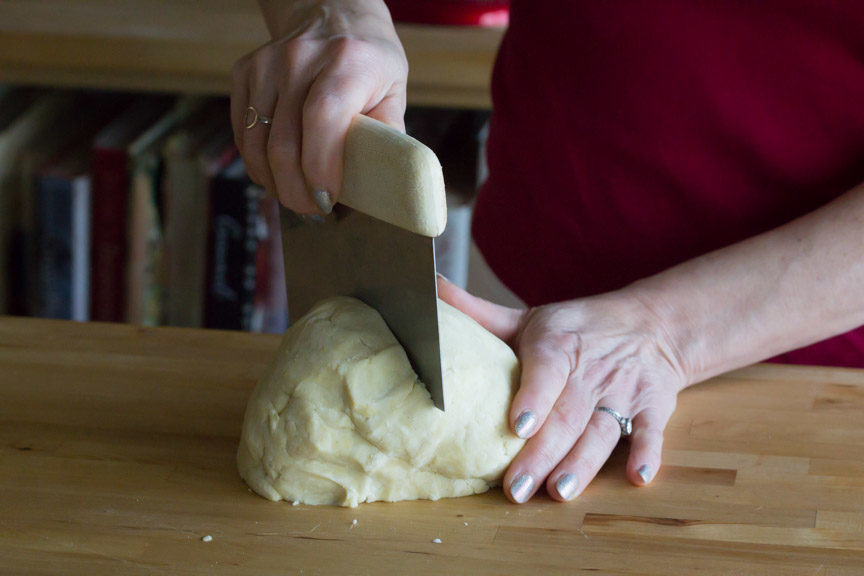
Below you can see the pockets of butter in the dough, which creates the flaky layers.
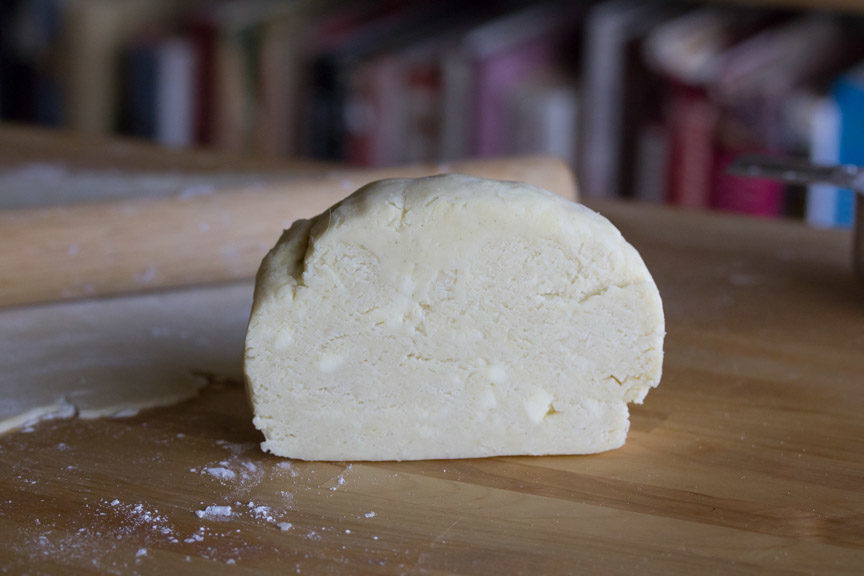
#1 Pie Crust Making Tip
Don’t be afraid! So many people think they can’t make homemade pie dough and really, it is either because they haven’t tried yet – because they are scared – or because they tried and it didn’t come out very well, in which case perhaps they didn’t have a really well developed and tested recipe to guide them.
IF you follow our instructions, we promise that you will become a fabulous pie crust maker in no time! And if you are a visual learner, check out our video.
Let’s Get Flaky
Check out how shatteringly flaky this pie crust is. You are going to love making it – and easting it.

Use the Right Pan
Our low FODMAP pie recipes will call for specific size pie plates; please use what is asked for in individual recipes in order for your recipe to work flawlessly. A 9-inch (23 cm) pie plate is NOT the same as a deep-dish pie plate of larger proportions.
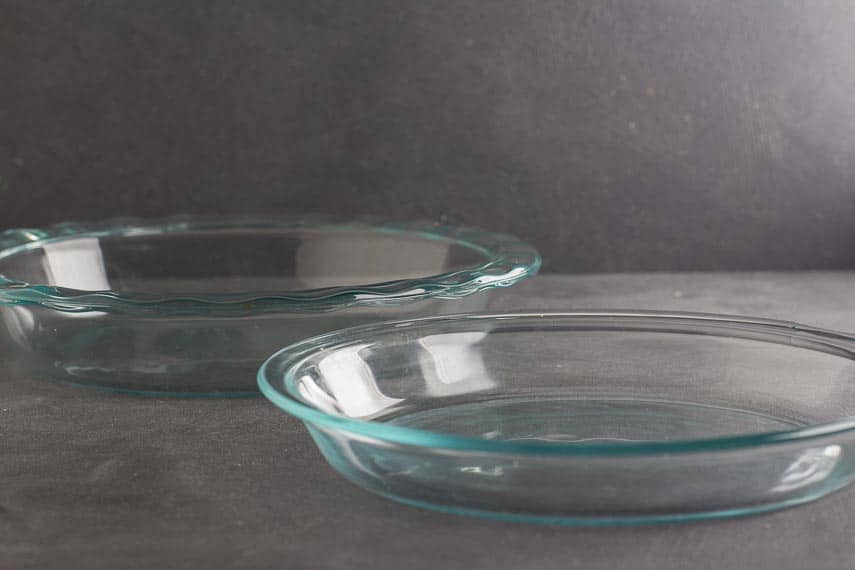
Low FODMAP Cream Cheese Pie Crust
We have another rich and flaky low FODMAP pie crust for you: our Low FODMAP Cream Cheese Pie Crust. We particularly love it or single crust pies, as seen below in our Fresh Blueberry Pie.
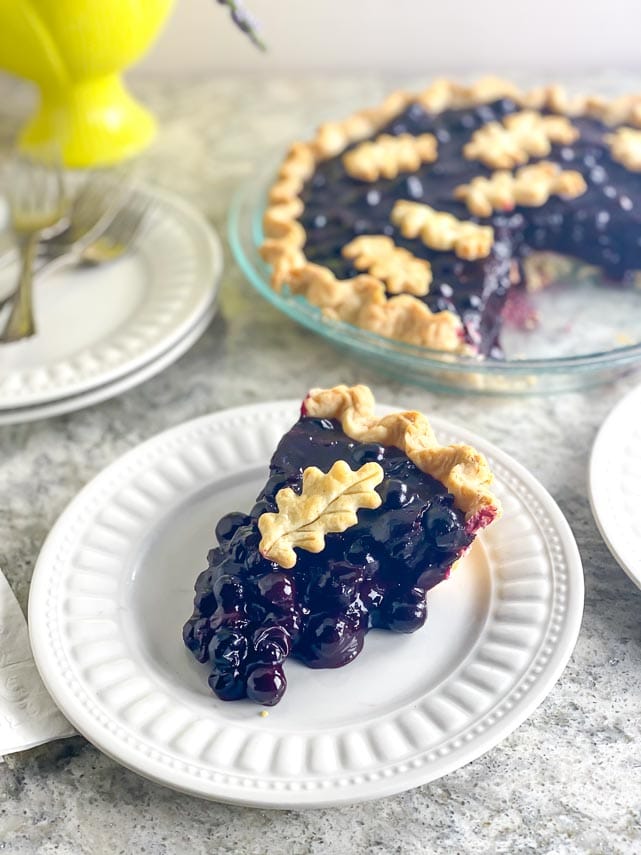
Looking for a Low FODMAP Tart or Crostata Crust Recipe?
We have that too! It is different and more specific for tart and crostata applications. Check out that recipe for Low FODMAP Tart & Crostata Crust. Then check out our Low FODMAP Rhubarb Raspberry Crostata, or our Low FODMAP Peach Blueberry Crostata, shown below.

Which Pie Will You Make First?
Here are just some of our recipes that use our Foolproof All Butter Low FODMAP Pie Crust recipes:
Low FODMAP Classic Pumpkin Pie

Our classic pumpkin pie is like the one of your childhood and dreams. No one will know this is a “diet” pumpkin pie! Get the recipe.
Low FODMAP Blueberry Pie

This classic two crust blueberry pie is based on the one my Nana used to make. It is bursting with blueberries and very juicy. Get the recipe.
Low FODMAP Chicken Pot Pie

We love savory pies and this chicken pot pie is probably our favorite. Get the recipe.
Low FODMAP Cranberry Snowdrift Pie

This recipe is a bit unusual. It features a sweet tart cranberry filling and is crowned with toasted meringue, no drift! And you get to haul out your propane torch. Get the recipe.
Low FODMAP Pumpkin Chiffon Pie

We have even more pumpkin pie recipes then we have mentioned on this page, but this is the lightest one. This low FODMAP Pumpkin Chiffon pie is a nice addition to any other pies you have on your holiday table. Get the recipe.
Low FODMAP Rhubarb Pie with Lattice Crust

We simply adore rhubarb and have low FODMAP several recipes for you. In the spring when it is at its peak we make as many rhubarb recipes as possible, and always include this lattice crust rhubarb pie. Get the recipe.
Low FODMAP Salted Caramel Apple Pecan Pie
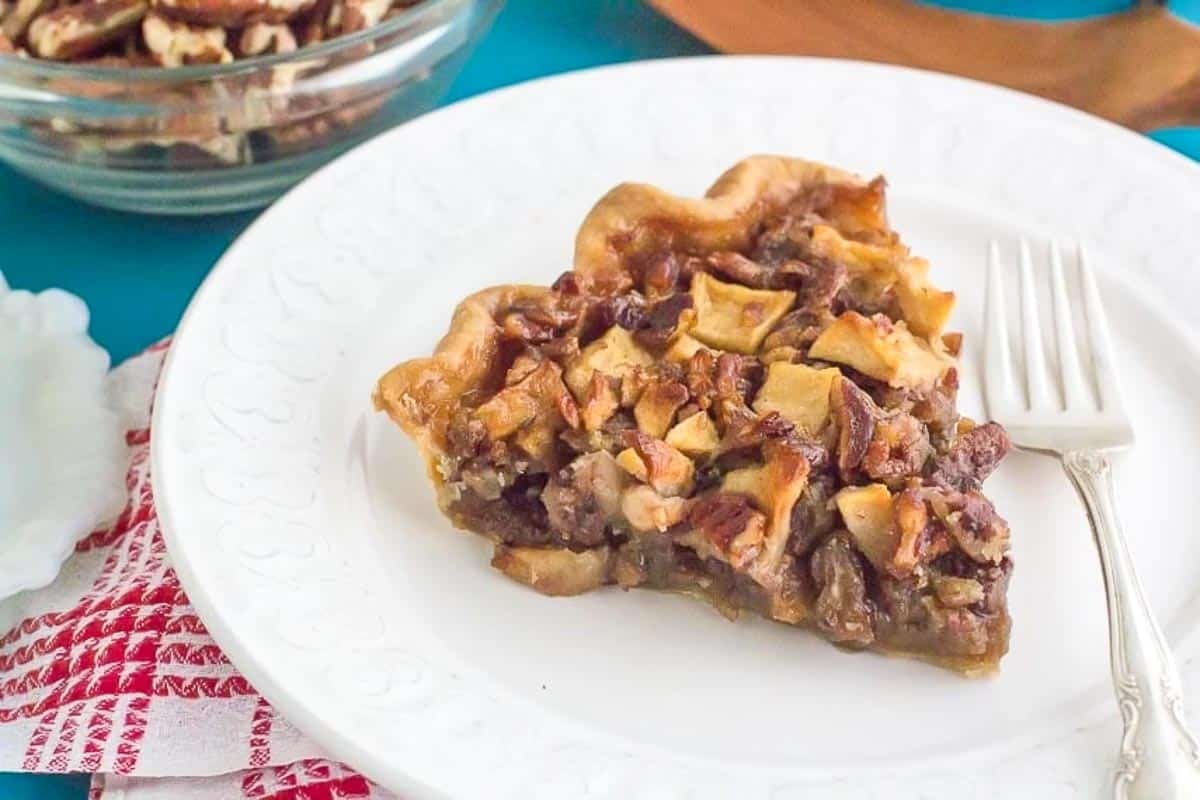
We hope the title of this recipe entices, because it’s certainly gets our mouth watering! Salted caramel is combined with low FODMAP amounts of apple and pecan for a unique pie that your guests will be clamoring for. Get the recipe.
Low FODMAP Banana Cream

Diner food at its best, Banana cream pie is a favorite for many, and our low FODMAP version tastes just like the classic. Get the recipe.
Low FODMAP Thanksgiving Leftover Pie

This Thanksgiving Leftover Pie is one of our most creative recipes and a perfect and artful way to use up what you have left the day after a big holiday meal. Get the recipe.
…and we have dozens more!

Foolproof All Butter Low FODMAP Pie Crust
Everyone needs a Foolproof All Butter Low FODMAP Pie Crust recipe that tastes great, has a flaky texture and is easy to work with. This has all of those features and it is gluten-free!
Low FODMAP Serving Size Info: Makes enough for a double crusted 9-inch (23 cm) pie; serving size depends on usage
Ingredients:
- 2 large eggs, cold
- 1/3 cup (75 ml) ice cold water
- 1/2 teaspoon apple cider or distilled white vinegar
- 2 1/2 cups (363 g) low FODMAP gluten-free all-purpose flour, such as Bob’s Red Mill Gluten Free 1 to 1 Baking Flour
- 1 tablespoon sugar, optional; use if making a sweet recipe
- 1/2 teaspoon xanthan gum
- 1/2 teaspoon salt
- 1 cup (2 sticks; 226 g) very cold unsalted butter, cut into tablespoon sized pieces
Preparation:
-
Whisk the eggs, water and vinegar together in a 2 cup (480 ml) measuring cup with spout and refrigerate until needed.
-
To Make by Hand: Whisk together the flour, sugar, if using, xanthan gum and salt in a medium bowl to blend. Add the butter and cut in, using a pastry blender or two knives, until the butter is cut into assorted sized pieces ranging from approximately ⅛ inch (3mm) to ½ inch (12 mm). Sprinkle wet mixture over the dry and toss with fingers or a fork until evenly moistened and the dough just holds together if squeezed.
-
To Make in a Stand Mixer: Put the flour, sugar, if using, xanthan gum and salt in the stand mixer bowl. Using flat paddle attachment, turn on low speed to blend dry ingredients. Add the butter and pulse on and off until the butter is cut into assorted sized pieces ranging from approximately ⅛ inch (3 mm) to ½ inch (12 mm). Sprinkle wet mixture over the dry and pulse on and off until dough is evenly moistened and the just holds together if squeezed.
-
To Make with a Food Processor: Put the flour, sugar, if using, xanthan gum and salt in the bowl of a food processor fitted with the metal blade attachment and pulse to combine. Add the butter and pulse on and off until the butter is cut into assorted sized pieces ranging from approximately ⅛ inch (3mm) to ½ inch (12 mm). Sprinkle wet mixture over the dry and pulse on and off until dough is evenly moistened and the just holds together if squeezed.
-
To Finish for All Techniques: Empty dough onto work surface and use hands to bring together gently. Divide in half, form each portion into a ball and flatten. Unlike pie crusts made with wheat flour, we have found that you don’t have to rest the dough! You can roll it out right away. Simply proceed as directed in individual recipes. You can also refrigerate or freeze the dough, although we like working with fresh best. Wrap each disc in plastic wrap and refrigerate up to 2 days or freeze for 1 month, in which case protect it further by placing in a plastic zipper-top bag; defrost in the refrigerator overnight. Let the dough soften at room temperature before rolling out, then proceed as directed in individual recipes.
-
To Blind Bake: Some recipes will call for a partially baked (par-baked) or fully baked, yet unfilled pie crust. After dividing your dough in half, proceed as follows: Preheat oven to 375°F/190°C. Coat your pie plate of choice (size suggested in recipe) with nonstick spray. Roll dough out to about ⅛ inch (3 mm) thickness on a lightly floured piece of parchment paper to a 12 to 13-inch (30.5 cm to 33 cm) round. Use parchment paper to lift dough and invert over prepared pan. Peel parchment away and discard. Carefully press dough into pie plate. Trim edges with scissors, fold under and crimp as desired. Line pie crust with aluminum foil and then fill foil with pie weights, dried beans or rice (this keeps the crust from bubbling up). Bake for about 8 to 10 minutes or until crust is beginning to set. Remove foil and weights and continue baking for a few minutes or until desired doneness. If you want to partially bake the crust because it will be going in the oven again with a filling, only bake until crust is dry, but not colored. If you want a fully baked crust, bake until golden brown, which could be another 5 to 10 minutes. Cool and proceed as individual recipes suggest.
Dédé’s Quick Recipe Tips Video
Notes:
Tips
- Even if you have passed the fructan wheat Challenge you CANNOT simply substitute all-purpose, wheat-based flour in this recipe. It will not work. This recipe was developed to be gluten-free and low FODMAP and you must use the ingredients suggested for best results.
Nutrition
All nutritional information is based on third-party calculations and should be considered estimates. Actual nutritional content will vary with brands used, measuring methods, portion sizes and more. For a more detailed explanation, please read our article Understanding The Nutrition Panel Within Our Recipes.

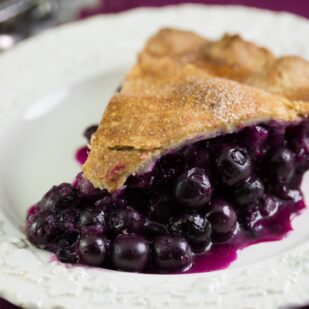





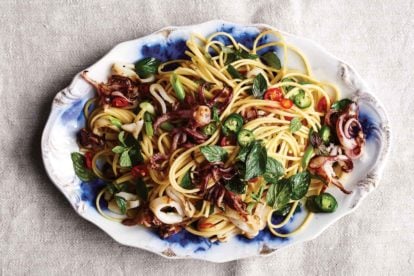
I am going to try the recipe for All Butter Pie Crust. I see it calls for XanthamGum. My GF flour mix has XG in it. What happens if I add the 1/2 teaspoon called for in the recipe?
Hi there! The flour that we use contains xanthan gum. You can read more here. This recipe calls for extra xanthan to help create a very workable texture.
If I don’t add the extra xanthan gum, will it not work?
It will not be the same and will tend to crumble. You could try working the dough very hard, making sure everything is very well mixed and homogenous. Err on the side of over-mixing. This will eliminate the flaky aspects of the crust, but you might have a better shot at being able to roll it out.
I would like to see you cooking. I hope one day you videos. Nice and useful page
Hello! We have a few videos up on Youtube that are of me cooking (from our sister site, Bakepedia). Enjoy! There will be more to come.
Can you use non-dairy butter?
You can – in theory. The texture will not be the same when finished and also the ease of working with the dough will not be the same. Keep everything really cold. I cannot guarantee results, but if you must go non-dairy, I would say try! AND if you do, we would love to know your experience! If you post here it could help others. Thank you for being part of our community!
Do you think this will freeze well? I want to make crust at home and freeze it so I can take it with me (on a plane) to my Thanksgiving destination, then make a fruit pie when I get there. So the dough would be thawed in the fridge then left on the counter to soften a bit before rolling. I’m thinking I should do a trial run/sample pie this weekend, to make sure I don’t serve my family a gross pie!
Great question and I have the answer; No.(Sorry!) I used to make this crust ahead and chill and it suffers greatly in texture. It makes it MUCH harder to roll out and becomes crackly and crumbly. If you look at the directions, it is very quick to throw together. My advice would be to put your flour and salt in a zip top bag. Buy butter when you get there…make it when you need it. The exception would be if you are making a single crust pie, you could make it, roll it out, fit into a pic dish and freeze that. BUT I cannot imagine how you could guarantee that it would travel well without getting banged up.
I have made gf crusts ahead of time and I find that rolling them out before chilling them is best. Roll them out between two sheets of plastic wrap. Chill. Let them sit for 30 minutes to warm up. Take off one plastic sheet, put crust in pan, take off other plastic sheet.
I actually had published this recipe before with chilling as part of the process. Once I started NOT chilling it, there was no comparison in the ease in which it handled. You can chill if you like, but I do not recommend it and think that the handle-ability and the ultimate texture are not as good.
I wonder if this would work with flax eggs.
The recipe has not been tested with them but you could try. Let us know if you do!
I can’t tolerate xantham, but have had luck replacing it with the same amount of CMC in baked goods. Any idea how much I’d need to use to replace the extra xantham plus what’s already in your flour mix?
Great question to which I do not have an answer. If you have been tinkering with it as an additive, I would follow your instincts and play. And then let us know for sure! Your experimentation could help others.
Made this recipe for the first time – pecan pie for one and blind baked the other.
So flaky it is amazing! Thank you so much for this great recipe.
YAY! Time for more pies:)
I am very sensitive to dairy products. Would this work with something like Earth Balance Buttery Sticks (non dairy)?
It would create some sort of pie dough but it will not be the same. I cannot guarantee the results. Try freezing the sticks.
I just made this crust for a low FODMAP spinach quiche, and it turned out great! It was my first attempt at baking with gluten-free flour, but it will certainly not be my last. Next up: your zucchini lemon bread (https://www.fodmapeveryday.com/recipes/low-fodmap-lemon-zucchini-bread/).
By the way, thank you for all the wonderful recipes. IBS has made it hard for me to enjoy food, but this website is giving me hope that I can have a varied AND flavourful diet again.
Magalie! YAY! So thrilled to hear that the crust worked well for you. It is a GREAT recipe and your comment will encourage others. Thank you for taking the time to write! Happy BAKING! And your general enthusiastic comment made by day:)
I was beginning to believe there was not a good FODMAP friendly pie crust dough recipe out there. Then, I found this recipe. 🙂 It is SO wonderful!!! Easy to make, easy to handle, and oh, so, very flaky! And the flavor is not too far off from a wheat flour dough — I was amazed by that!
I also decided to try mixing it with a stand mixer; I usually use a pastry blender. Oh, my goodness! That was so much easier than the pastry blender! I think I’ve found a new way to mix pie crust dough. 🙂
I made a pecan pie with this crust, and it turned out great and very tasty! Thank you so much for coming up with this recipe! It is now my go-to pie crust dough recipe. 🙂
Beth, you made my week! Thank you so much for this note. I totally agree with you that if you have a stand mixer, but it to work!!!! So happy that you found our recipes – and that you shared your joy. PS: Try the Cream Cheese crust next!